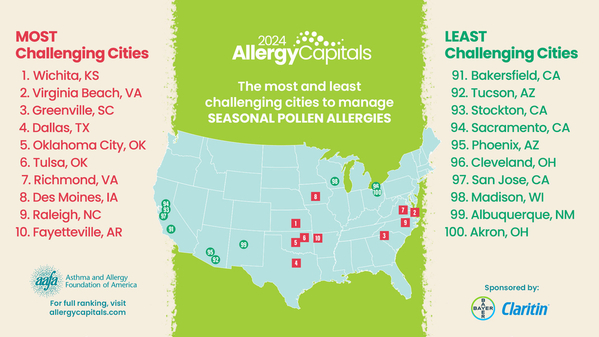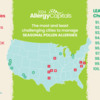The Asthma and Allergy Foundation of America (AAFA) released our 2024 Allergy Capitals™ report.
AAFA’s report ranks the top 100 most challenging cities in the contiguous United States (“lower 48 states”) to live with seasonal pollen allergies. The report includes data from the previous year to create a ranking of the 100 most populated cities based on:
- Tree, grass, and weed pollen scores
- Over-the-counter allergy medicine use
- Availability of board-certified allergists/immunologists
Wichita, Kansas, is the #1 Allergy Capital for the second year in a row due to:
- Higher-than-average tree and grass pollen
- Higher-than-average allergy medicine use
- Fewer board-certified allergists/immunologists
See the full ranking of 100 cities: allergycapitals.com
What Does It Mean If I Live in a Top Allergy Capital?
About 1 out of 4 adults and 1 out of 5 children have seasonal allergic rhinitis, also known as “hay fever.” If you have seasonal allergies and live in a top Allergy Capital, seasonal allergies may affect you more.
If your city is a top Allergy Capital, it may have higher-than-average pollen counts, high sales of over-the-counter allergy medicine, and fewer allergists. Read the report to find out how your city ranks and what you can do to take care of your allergies.
Are Pollen Seasons Getting Worse?
It’s not just your imagination. Pollen seasons start earlier, last longer, and are more intense. Climate change and botanical sexism are to blame. Due to climate change, there is also an increase in carbon dioxide in the air, causing trees to make more pollen.
“Botanical sexism” refers to the preference to plant “male” (wind-pollinating) trees instead of “female” (fruit-, seed-, and nut-bearing trees). More wind-pollinating trees can lead to more pollen.
Read the report to learn more about the effects of climate change and botanical sexism.
Claritin’s DiversiTree Project
Did you know that male trees produce pollen and female trees produce seeds? In 1949, the USDA provided city planting guidance dictating that “only male trees should be planted.” This mandate led to an increase in pollen levels, expected to double by 2040. To help reverse this trend of planting male trees that’s contributed to allergies for the last 75 years, Bayer launched the Claritin DiversiTree Project in 2023. Today, all types of allergies affect over 30% of adults and 40% of kids in the United States. This is why Claritin is extending its mission by planting more female trees where kids need it the most—schools, parks, and playgrounds. Claritin is undertaking this initiative because they believe the world would be better if we could live as if we don’t have allergies.
What Does It Mean If I Live in an Allergy Capital Lower on the List?
You may still be greatly affected by seasonal allergies. On one or more of the ranked factors, your city may be doing better compared to other cities. For example, your city may have more allergists available compared to other cities.
What Does It Mean If My City Isn’t Listed on the Report?
AAFA's Allergy Capitals report ranks the top 100 populated metro areas in the United States. If your hometown is near a major city, your area may be included in the metro area of the major city. For example, the Seattle metropolitan area includes Tacoma, Bellevue, Everett, and all cities and suburbs in the surrounding area.
If your city's population is lower than the population of the 100th most populated city, then your city will not be ranked. You may be greatly affected by seasonal allergies, but your town is not reflected in the report. This is why Scranton, Pennsylvania – a city that was named an Allergy Capital for the past few years – is not ranked on this year's report. As of 2022, Scranton is no longer one of the 100 most-populated cities. Instead, it has been replaced by Fayetteville, Arkansas, moving it off our list.
How Can I Get Relief from Seasonal Allergies?
No matter where you live, it’s hard to escape pollen. But you can manage your pollen allergy.
There are a number of available and accessible options to help you find relief. Work with your doctor to include the steps below in your allergy treatment plan:
1. Limit your contact with pollen. Here are some steps you can take to reduce your contact with pollen during pollen season:
- Check pollen counts daily.
- Plan outdoor activities on low pollen days.
- Stay inside on high pollen days.
- Outside, wear sunglasses, a hat or head covering, and a mask to limit the amount of pollen that gets into your eyes, nose, mouth, and lungs.
- Remove your shoes before entering your home.
- Change and wash clothes after outdoor activities.
- Wipe furry animals off when they come inside or bathe them weekly.
- Shower before bed to keep pollen out of your bedding.
- Keep windows closed during pollen season or peak pollen times (usually midday).
- Use central air conditioning or air cleaners with a HEPA or CERTIFIED asthma & allergy friendly® filter, if possible.
- Clean bedding, floors, and fabric furniture once a week.
- Clean blinds, curtains, and washable rugs once a month.
2. Use allergy medicines and treatments. There are over-the-counter and prescription options to help you prevent or treat allergy symptoms.
- Nasal corticosteroid sprays
- Long-acting antihistamines
- Decongestants
- Cromolyn sodium
- Leukotriene receptor antagonists (or modifiers)
Some of these treatments work best if you start them a couple of weeks before your allergy season begins. Talk with your doctor before and after the start of any new medicine.
3. Rinse out your nose with a saline solution made with distilled water. A nasal rinse can help clear your sinuses and nose. This can help remove pollen and mucus. It may be best to do a nasal rinse before you use a medicine nasal spray. Rinse your nose with warm saline solution (salt water) using a Neti pot or a special rinse bottle.
4. Ask your doctor about immunotherapy. If you do not get complete relief from medicines, talk with your allergy doctor about immunotherapy. There are two types of immunotherapy: allergy shots and sublingual (under-the-tongue) immunotherapy.
For more tips, learn more about managing pollen allergies.
The 2024 Allergy Capitals report is an independent research project of the Asthma and Allergy Foundation of America and made possible by support from Bayer Claritin®.
AAFA thanks Pollen Sense, Komodo Health, and Circana for their support with data and report content.
The views and opinions expressed in this report are those of the AAFA authors and do not necessarily reflect the policies or positions of other individuals, sponsors, organizations, or companies.
How Can I Learn More About the Report?
The Allergy Capitals™ ranking is an annual research and education project from AAFA. We release the report to help people recognize, prevent, and safely treat allergy symptoms. Through this ranking, AAFA raises awareness about the impact of seasonal allergies. It provides helpful information that can improve the quality of life for people living with seasonal allergies.
Visit allergycapitals.com to see the full list and to learn more about allergy diagnosis, prevention, and treatment.
Join our online community where you can get support for asthma and allergies and stay up to date on news and research.




Comments (0)